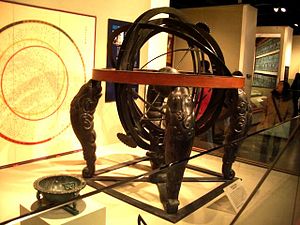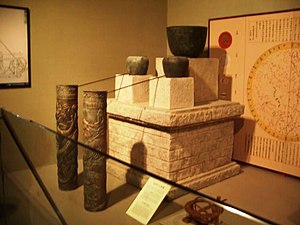Benutzer:Kmarhold/Jang Yeong-sil

| |
| Koreanische Schreibweise | |
|---|---|
| Hangeul | 장영실 |
| Hanja | 蔣英實 |
| Revidierte Romanisierung |
Jang Yeong-sil |
| McCune- Reischauer |
Chang Yŏngsil |
Jang Yeong-sil war ein bedeutender koreanischer Wissenschafter und Astronom während der Joseon-Dynastie (1392–1910). Obwohl Jang durch seine Geburt einer niedrigen Klasse angehörte, ermöglichte es die Politik von König Sejong (r. 1418–1450), der nicht die Abstammung, sondern die in staatlichen Prüfungen zur Schau gestellte Leistung als Kriterium für die Vergabe von Positionen etablierte, dass er im Palast an großem Einfluss gewann. Seine zahlreichen Erfindungen, darunter Geräte zur Messung von Niederschlag und Wasseruhren, sind stellvertretend für den technologischen Fortschritt Koreas unter der Joseon-Dynastie.
Anfangsjahre[Bearbeiten | Quelltext bearbeiten]
Aufzeichnungen über die Geburt Jang Yeong-sils finden sich in den Aufzeichnungen der Jang Familie[1][2] und in den Annalen der Joseon-Dynastie.[3] Aufzeichnungen über Jangs Familie lassen den Schluß zu, dass es sich um eine Familie mit hohem offiziellen Status gehandelt hat, die nach dem Machtwechsel in Korea, und der Gründung der Joseon Dynastie in Ungnade gefallen war. [4][5] Jangs Leistungen ermöglichten ihm ein Position am Hof in Hanseong (dem heutigen Seoul), wo er von König Sejong eine Stelle als Beamter zugewisen bekam.[6] Jang und andere rekrutierte Wissenschafter arbeiteten in einer Behörde, die als Jiphyeonjeon (집현전; 集賢殿) bekannt war.[7]
Innovationen von Jang Yeong-sil[Bearbeiten | Quelltext bearbeiten]
Astronomische Instrumente[Bearbeiten | Quelltext bearbeiten]

Eine der ersten Aufgaben, mit dener Jang betraut wurde war die Konstruktion einer Armillarsphäre. Korea hatte auf diesem Gebiet zwar bereits Wissen aus China und dem arabischen Raum erhalten, die Konstruktionszeichnungen waren jedoch unvollständig. Nach rund zwei Monaten erstellte Jang einen ersten Prototypen, und im Jahr 1433, wurde dashoncheonui (혼천의, 渾天儀) fertiggestellt. Im Inneren des befand sich ein Wasserrad das um die Zeit anzuzeigen, die innere Schale drehte.[8] Dieser Mechanismus erlaubte es, die Position von Sonne, Mond und Sternen zu jeder Tageszeit anzuzeigen. [9] Spätere Modelle(z.B. das gyupyo (규표)) berücksichtigten auch jahreszeitliche Veränderungen.[10] Diese Instrumente wurden im Gyeongbokgung aufgestellt und von den Hofastronomen verwendet.[11]
Druckerpresse[Bearbeiten | Quelltext bearbeiten]
Although Choe Yun-ui (최윤의) invented the world's first metal printing press in 1234 during the Goryeo Dynasty,[11] Johann Gutenberg is recognized worldwide as the first to pioneer this technology. In general, metal movable type printing blocks surpassed the wooden counterparts in durability, clarity, and longevity.[12] Even then, the king asked the scientists at Jiphyeonjeon to build a better printing press. In 1434,[13] the scientists accomplished in building Gabinja (갑인자, 甲寅字),[14] which was made of copper-zinc and lead-tin alloys.[15] It was said to be twice as fast as the previous printing presses and print the Chinese characters in astounding beauty and clarity. Gabinja was reproduced six times during the next 370 years.[15]
Wasseruhr[Bearbeiten | Quelltext bearbeiten]

Self-striking water clocks had already been invented by the Arabians and the Chinese (in 1091),[16] and a more primitive form was in use by the Koreans. Although it is believed, Samguk Sagi records that an office overseeing the use of water clocks had been established during the Three Kingdoms Period.[11] The Korean version consisted of two stacked jars of water, with water dropping from the top to the bottom at a measured rate. The level of the water indicated the time of the day. This was very inconvenient because a person had to be always be on guard, so that at each hour he or she could bang a drum to inform the public.
Upon hearing about the usage of self-striking water clocks in foreign countries, Sejong assigned Jang and other scientists to build a clock emulating such automatic devices. They failed in developing an operational water clock. Therefore, Jang went to China to study the various designs of water clocks. When he returned in 1434, Jang created Korea's first water clock, Jagyeokru (자격루).[17] This water clock did not survive; however, reconstructions of the Jagyeokru based on text descriptions have been made.
Circling the clock were 12 wooden figures that served as indicators of time. There were four water containers, 2 jars that received the water, and 12 arrows floating inside the lower container. As the water from the upper containers seeped down the pipe to the lower container, one of the arrows would tilt a board filled with small iron balls; a ball would roll down a pipe to a container of larger iron balls. The collision would cause the larger balls to travel down a lower pipe and hit a giant cymbal, announcing the time to the community. Then, the ball would land on another container, which is part of a complex of levers and pulleys that activates the motions of the wooden figures to indicate time visually.[18]
Sonnenuhr[Bearbeiten | Quelltext bearbeiten]

Jang's invention of the water clock saw its infusion throughout the country. Yet, these were very costly, and the cheaper and more manageable alternative came about to be the sundial. Jang, Ichun, Kimjo, and other scientists made Korea's first sundial, Angbu Ilgu (앙부일구) (仰釜日晷),[19] which meant "pot-shaped sun clock staring at the sky".[20] Angbu Ilgu was bronze in composition, and consisted of a bowl marked with 13 meters to indicate time and four legs jointed by a cross at the base.[20] 7 lines crossed the 13 meters in different curves to compensate for the seasonal changes of the course of the sun.[20] Angbu Ilgu and other variants, such as the Hyunjoo Ilgu and the Chunpyung Ilgu, were implemented in strategic spots, such as the main streets with heavy traffic, so that the people could be well informed of the time. To compensate for the high illiteracy rate among the commoners, 12 shapes of animals, such as mouse, tiger, and cow, were engraved in juxtaposition with the meters.[20] No extant Joseon Dynasty sundials today were made during King Sejong's reign, none known to have survived past Imjin wars (임진왜란).
Materialforschung[Bearbeiten | Quelltext bearbeiten]
When King Sejong learned of reports that Korean melee weapons were duller and somewhat heavier than those of the neighboring countries, he sent Jang to Gyeongsang province, where he had spent his earlier life, to develop metal alloys for various weapons and tools. Since Jang used to be a gwan-no, he had already acquired much knowledge about metal working and also knew the geography of the area. Jang surveyed the available metals and their characteristics, and presented his research to king and the generals, contributing to the development of Korean weaponry.[21]
Niederschlagsmesser[Bearbeiten | Quelltext bearbeiten]
The Korean economy during the Joseon Dynasty was agriculturally based and was vulnerable to elongated or consecutively occurring droughts. Therefore, there was a need for better ways to manage water. Although rain gauges had been used in ancient Greece and India,[22] Jang invented Korea's first rain gauge in 1441, called cheokugye (측우기),[23][24][25][26][27] and, by 1442, a standardized rain gauge with dimensions of 42.5 cm (height) and 17 cm (diameter) was introduced throughout the country to gather data on the yearly averages of precipitation throughout the different regions of the country.[7]
Vertreibung vom Hof und Tod[Bearbeiten | Quelltext bearbeiten]
Dass Jang es geschafft hatte trotz seines sozialen Hintergrundes das Vertrauen des Königs zu gewinnen und am Hof in der Hierarchie aufzusteigen, brachte ihm viel Neid von Seiten anderer Regierungsbeamter ein. Ein weiteres Problem, von dem nicht nur Jang, sondern auch viele seiner Kollegen betroffen waren, war die Tatsache dass im neokonfuzianistischen Szstem der JoseonßDynastie Wissenschafter und Ingenieure nicht hoch angesehen waren. Im Jahr 1442 wurde Jang beauftragt eine Sänfte für den König zu bauen, die jedoch als sie der König benutzte, zerbrach. Jang wurde für mehrere Jahre eingesperrt und des Palasts verwiesen. Damit verlieren sich auch seine Spuren, über sein späteres Leben und den Zeitpunkt seines Todes gibt es keine bekannten Aufzeichnungen.[28]
Siehe auch[Bearbeiten | Quelltext bearbeiten]
Weblinks[Bearbeiten | Quelltext bearbeiten]
- Newton Graphic Science Magazine, biography (Koreanisch)
- Youth Korea Times article (Koreanisch)
- Seoul National University profile (Koreanisch)
Einzelnachweise[Bearbeiten | Quelltext bearbeiten]
- ↑ "The genealogy of A-san Jang-si", book 1, pp.4, 1872, (牙山蔣氏世譜卷之一黃)
- ↑ Jonghwa Ahn, Kook-Jo-In-Mool-Ji, 1909, 國朝人物志 v.1, A biographical dictionary of Korea
- ↑ The article of 16 SEP 1433, Chosun Wangjo Sillok, King Sejong
- ↑ Dae-Dong-Woon-Boo-Goon-Ok, 1587, 大東韻府群玉
- ↑ p. 17 Baek Seokgi. (1987). Woongjin Wi-in Jeon-gi #11 Jang Yeong-sil. Woongjin Publishing.
- ↑ p. 46-49 Baek Seokgi. (1987). Woongjin Wi-in Jeon-gi #11 Jang Yeong-sil. Woongjin Publishing.
- ↑ a b Korean History Project
- ↑ p. 55 Baek Seokgi. (1987). Woongjin Wi-in Jeon-gi #11 Jang Yeong-sil. Woongjin Publishing.
- ↑ p. 56 Baek Seokgi. (1987). Woongjin Wi-in Jeon-gi #11 Jang Yeong-sil. Woongjin Publishing.
- ↑ p. 77 Baek Seokgi. (1987). Woongjin Wi-in Jeon-gi #11 Jang Yeong-sil. Woongjin Publishing.
- ↑ a b c Indiana University Resources
- ↑ The Invention of Movable Type
- ↑ Glossary of Korean Studies
- ↑ p. 63 Baek Seokgi. (1987). Woongjin Wi-in Jeon-gi #11 Jang Yeong-sil. Woongjin Publishing.
- ↑ a b Federation of Busan and Technology
- ↑ p. 68 Baek Seokgi. (1987). Woongjin Wi-in Jeon-gi #11 Jang Yeong-sil. Woongjin Publishing.
- ↑ p. 71 Baek Seokgi. (1987). Woongjin Wi-in Jeon-gi #11 Jang Yeong-sil. Woongjin Publishing.
- ↑ p. 72-73 Baek Seokgi. (1987). Woongjin Wi-in Jeon-gi #11 Jang Yeong-sil. Woongjin Publishing.
- ↑ p. 75 Baek Seokgi. (1987). Woongjin Wi-in Jeon-gi #11 Jang Yeong-sil Woongjin Publishing.
- ↑ a b c d Kaeri Web Magazine
- ↑ p. 87-91 Baek Seokgi. (1987). Woongjin Wi-in Jeon-gi #11 Jang Yeong-sil. Woongjin Publishing.
- ↑ The Culture and Civilization of Ancient India in Historical Outline; Kosambi, 1982
- ↑ p. 97 Baek Seokgi. (1987). Woongjin Wi-in Jeon-gi #11 Jang Yeong-sil. Woongjin Publishing.
- ↑ Visit Busan Museum Guide
- ↑ American Meteorological Society press
- ↑ Education About Asia, Vol. 6, #2, Fall, 2001.
- ↑ Friendly Korea brief on Korean history
- ↑ p. 108-111 Baek Seokgi. (1987). Woongjin Wi-in Jeon-gi #11 Jang Yeong-sil. Woongjin Publishing.
Vorlage:Persondata {{DEFAULTSORT:Jang, Yeong-Sil}} [[Category:Joseon Dynasty people]] [[Category:Korean scientists]] [[Category:Medieval Korean astronomers]] [[Category:14th-century births]] [[Category:Year of birth unknown]] [[Category:Year of death unknown]]